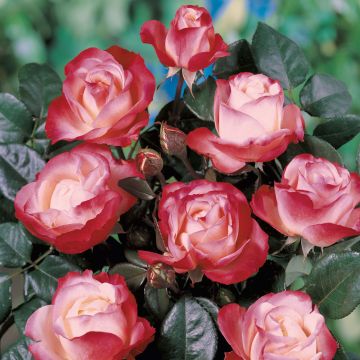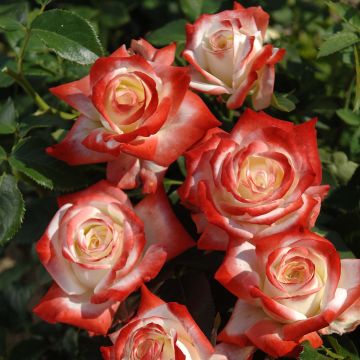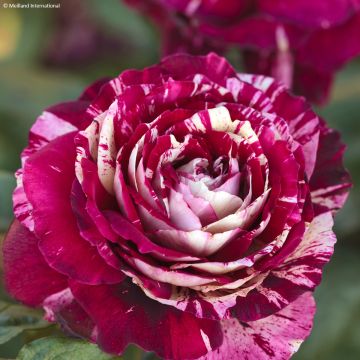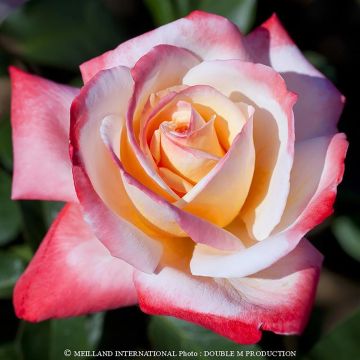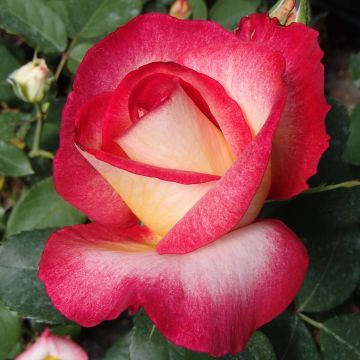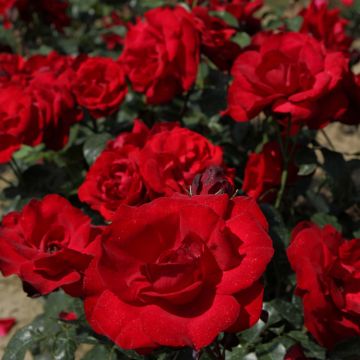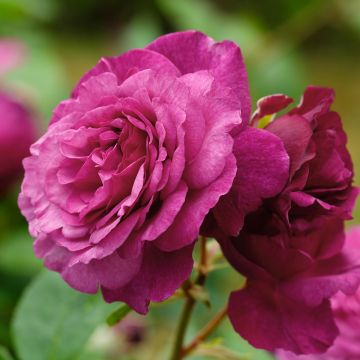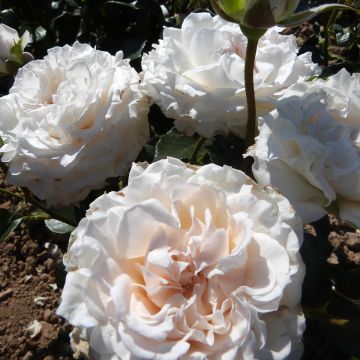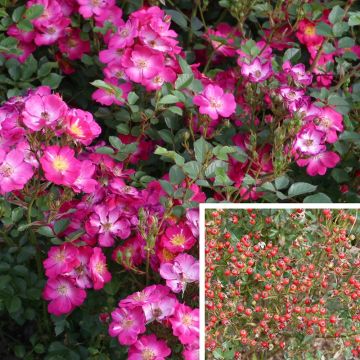

Rosier à grandes fleurs Henryane de Chaponay ®


Rosier à grandes fleurs Henryane de Chaponay ®
Rosa Henryane de Chaponay
Rosa Henryane de Chaponay Ora 351
Rose
Why not try an alternative variety in stock?
View all →This plant carries a 24 months recovery warranty
More information
We guarantee the quality of our plants for a full growing cycle, and will replace at our expense any plant that fails to recover under normal climatic and planting conditions.
From €5.90 for pickup delivery and €6.90 for home delivery
Express home delivery from €8.90.
From €5.90 for pickup delivery and €6.90 for home delivery
Express home delivery from €8.90.
Delivery to Corse prohibited: UE law prohibits the import of this plant from mainland France to Corse as part of the fight against Xylella fastidiosa. Please accept our sincere apologies.
More information

Does this plant fit my garden?
Set up your Plantfit profile →
Description
The Rosier Henryane de Chaponay® is a modern hybrid that doesn't go unnoticed in the garden, to say the least, given its vibrant and shimmering flowering in a combination of yellow and orange tones of incomparable luminosity. On this robust, vigorous and healthy bush, with dark and glossy foliage, these roses with perfect turbinate shape, typical of tea hybrids, succeed each other for months, with a light fragrance. Radiant in a massif or in a small hedge, they are perfect for bouquets.
'Henryane de Chaponay' (Ora 351) is a recently obtained large-flowered bush rose by Orard. It received the Certificate of Merit in Monaco in 2018, as well as the first prize in the Large-Flowered Bushes category awarded by the SNHF in 2020. This competition rewards recent creations evaluated in seven different cultivation sites, spread across France, without the use of chemical treatments. The awarded varieties, also evaluated for their ornamental qualities, are particularly easy to grow in various conditions. The Henryane de Chaponay rose is a bushy and erect shrub that reaches a height of 90cm (35in) to 1m (3ft) with a spread of 60cm (24in) at maturity, with rapid growth. It produces strong, somewhat stiff, thorny branches that carry very elegant, solid foliage, dark green and resistant to diseases. Throughout the summer, if faded flowers are removed, the plant continuously produces large turbinate flowers measuring over 10cm (4in) in diameter, composed of 30 petals. They are solitary or grouped in small bouquets and borne at the tips of long shoots from the current year or emerging from 2-year-old stems. The deciduous foliage falls in autumn and reappears in spring.
This Henryane de Chaponay rose, with its very dynamic colour, is ideal as a solitary plant in a well-maintained small garden. It is also perfect for use in large monochrome borders, as its rich colour can be difficult to match. For example, it can be associated with white Phlox paniculata, red Penstemon, daisies, chocolate cosmos, as well as the dark foliage of certain Physocarpus ('Burgundy Candy'), or the feathery foliage of bronze fennel. Its long-lasting cut flowers are naturally perfect for bouquets.
Report an error about the product description
Plant habit
Flowering
Foliage
Botanical data
Rosa
Henryane de Chaponay Ora 351
Rosaceae
Rose
Cultivar or hybrid
Other Large-flower tea Roses
Planting and care
Plant your Henryane de Chaponay Rose bush in a sunny or lightly shaded location. Modern roses are tolerant but do not appreciate excessive limestone. They will adapt to any garden as long as the soil is well worked, not too heavy, and sufficiently rich. To install your rose bush, work the soil by breaking it up well and put an amendment at the bottom of the planting hole, such as dried blood or dehydrated horn. Water generously after planting to eliminate air pockets. Regularly water for a few weeks to facilitate rooting.
Pruning modern perpetual roses is essential for flowering. It is done in three steps:
1. Maintenance pruning : regularly shorten the flowering branches during the season. To encourage the reblooming of perpetual roses, remove faded flowers at the same time as their stem, leaving 2 or 3 leaves.
2. Preparatory pruning in autumn : light pruning that anticipates the true spring pruning.
In regions with cold winters, it is not recommended to avoid weakening the bush.
3. Spring pruning : in February-March, when the buds have become shoots 2 to 3cm (1in) long: prune the young strong branches to a quarter of their length.
Pruning always aims to clear the centre of the bush and remove dead wood, diseased branches, and weak shoots. The most vigorous ones will be kept, usually 3 to 6 well-positioned branches to maintain a beautiful habit. Always prune at a slant ½cm or 1cm above a bud facing outward.
Planting period
Intended location
Care
-
, onOrder confirmed
Reply from on Promesse de fleurs
Roses by producer
Haven't found what you were looking for?
Hardiness is the lowest winter temperature a plant can endure without suffering serious damage or even dying. However, hardiness is affected by location (a sheltered area, such as a patio), protection (winter cover) and soil type (hardiness is improved by well-drained soil).

Photo Sharing Terms & Conditions
In order to encourage gardeners to interact and share their experiences, Promesse de fleurs offers various media enabling content to be uploaded onto its Site - in particular via the ‘Photo sharing’ module.
The User agrees to refrain from:
- Posting any content that is illegal, prejudicial, insulting, racist, inciteful to hatred, revisionist, contrary to public decency, that infringes on privacy or on the privacy rights of third parties, in particular the publicity rights of persons and goods, intellectual property rights, or the right to privacy.
- Submitting content on behalf of a third party;
- Impersonate the identity of a third party and/or publish any personal information about a third party;
In general, the User undertakes to refrain from any unethical behaviour.
All Content (in particular text, comments, files, images, photos, videos, creative works, etc.), which may be subject to property or intellectual property rights, image or other private rights, shall remain the property of the User, subject to the limited rights granted by the terms of the licence granted by Promesse de fleurs as stated below. Users are at liberty to publish or not to publish such Content on the Site, notably via the ‘Photo Sharing’ facility, and accept that this Content shall be made public and freely accessible, notably on the Internet.
Users further acknowledge, undertake to have ,and guarantee that they hold all necessary rights and permissions to publish such material on the Site, in particular with regard to the legislation in force pertaining to any privacy, property, intellectual property, image, or contractual rights, or rights of any other nature. By publishing such Content on the Site, Users acknowledge accepting full liability as publishers of the Content within the meaning of the law, and grant Promesse de fleurs, free of charge, an inclusive, worldwide licence for the said Content for the entire duration of its publication, including all reproduction, representation, up/downloading, displaying, performing, transmission, and storage rights.
Users also grant permission for their name to be linked to the Content and accept that this link may not always be made available.
By engaging in posting material, Users consent to their Content becoming automatically accessible on the Internet, in particular on other sites and/or blogs and/or web pages of the Promesse de fleurs site, including in particular social pages and the Promesse de fleurs catalogue.
Users may secure the removal of entrusted content free of charge by issuing a simple request via our contact form.
The flowering period indicated on our website applies to countries and regions located in USDA zone 8 (France, the United Kingdom, Ireland, the Netherlands, etc.)
It will vary according to where you live:
- In zones 9 to 10 (Italy, Spain, Greece, etc.), flowering will occur about 2 to 4 weeks earlier.
- In zones 6 to 7 (Germany, Poland, Slovenia, and lower mountainous regions), flowering will be delayed by 2 to 3 weeks.
- In zone 5 (Central Europe, Scandinavia), blooming will be delayed by 3 to 5 weeks.
In temperate climates, pruning of spring-flowering shrubs (forsythia, spireas, etc.) should be done just after flowering.
Pruning of summer-flowering shrubs (Indian Lilac, Perovskia, etc.) can be done in winter or spring.
In cold regions as well as with frost-sensitive plants, avoid pruning too early when severe frosts may still occur.
The planting period indicated on our website applies to countries and regions located in USDA zone 8 (France, United Kingdom, Ireland, Netherlands).
It will vary according to where you live:
- In Mediterranean zones (Marseille, Madrid, Milan, etc.), autumn and winter are the best planting periods.
- In continental zones (Strasbourg, Munich, Vienna, etc.), delay planting by 2 to 3 weeks in spring and bring it forward by 2 to 4 weeks in autumn.
- In mountainous regions (the Alps, Pyrenees, Carpathians, etc.), it is best to plant in late spring (May-June) or late summer (August-September).
The harvesting period indicated on our website applies to countries and regions in USDA zone 8 (France, England, Ireland, the Netherlands).
In colder areas (Scandinavia, Poland, Austria...) fruit and vegetable harvests are likely to be delayed by 3-4 weeks.
In warmer areas (Italy, Spain, Greece, etc.), harvesting will probably take place earlier, depending on weather conditions.
The sowing periods indicated on our website apply to countries and regions within USDA Zone 8 (France, UK, Ireland, Netherlands).
In colder areas (Scandinavia, Poland, Austria...), delay any outdoor sowing by 3-4 weeks, or sow under glass.
In warmer climes (Italy, Spain, Greece, etc.), bring outdoor sowing forward by a few weeks.



































